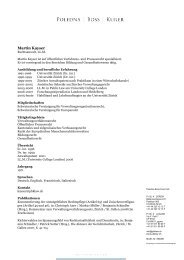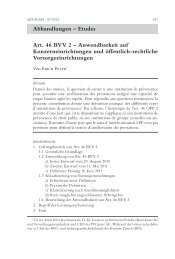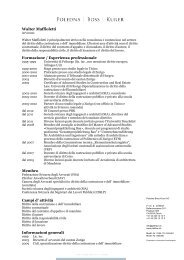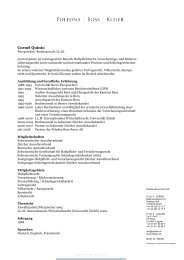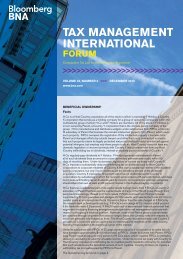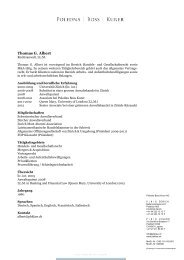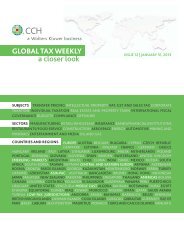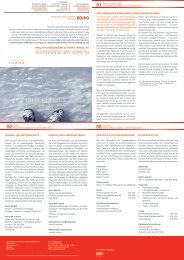The Inter-Governmental Agreements (IGAs)From quite early on, it became clear that the bureaucraticload on FFIs would be such that many ofthem would simply refuse to have American clients,which wasn't exactly what the Treasury had in mindwhen it promoted FATCA; so the idea emerged ofhaving agreements between the Treasury and foreigngovernments which would allow those governmentsto fulfill the requirements of FATCA by collectingthe necessary data from their own FFIs and sendingit in bulk to the IRS. Many governments turnedout to be quite happy to collect extra informationfor their own benefit as part of "helping" their FFIs,and the idea caught on rapidly, even leading somegovernments to impose their own "mini-FATCAS"on their FFIs and in the case of the UK, on its "offshore"dependent territories (see below).in respect of nationals of the partner country. Thismay come as an unwelcome surprise to US financialinstitutions, and some of the domestic difficultiesraised by FATCA are explored below.Both 1A and 1B straightforwardly place the partnergovernment in the shoes of FFIs in the countryconcerned; but they are not completely standardized.From the beginning, the templates allowedfor a degree of customization, and in fact there hasbeen quite a lot of that in the IGAs which have sofar been signed.The Treasury says it is negotiating IGAs with morethan 75 countries, of which it has listed about 50,but so far there seem to be just eight signed IGAs,of which just one is Model 2 (with Switzerland).There are now three types of IGA:1Model 1A ; Model 1B 2 ; and Model 2 3Model 2 merely agrees that the country concernedwill ensure that its laws and regulations permit itsFFIs to perform the reporting procedures laid outunder FATCA. In the case of Switzerland, for instance,this would not have been the case withoutchanges, which are being made.Model 1 implements FATCA as drafted, but itcomes in two forms: 1A, which is reciprocal, and1B which is not."Reciprocal" means that US FFIs will have to mirrorthe requirements of FATCA in the reverse directionAt the end of May, after signing its IGA with Germany,the Treasury said that in future it would limitthe customizable aspects of IGAs, given that the finalregulations issued earlier in the year were muchmore prescriptive than earlier texts.The Foreign Response To FATCAAt a guess, the Treasury must be quite pleased thatforeign governments have keeled over and rushedto enter IGAs, when they might have been expectedto rear up and cry "extra-territorial legislation."The reason, surely, is that any tax collector whocan say: "I have to ask you for information aboutyour clients' assets because the mighty USA says Imust," is surely going to grab at the chance. It's ashort step from there to imposing a kind of localFATCA on your own FFIs, or in the case of the12
UK, its offshore dependencies, and that is exactlywhat has happened.Th e United KingdomThe UK is in fact in a good position to make use ofa FATCA-like mechanism to forward the cause ofinternational tax transparency: as a former colonialpower, it retains some degree of control over manyfar flung dependent territories which also happento be classified as tax havens. Indeed the UK Governmenthas confirmed its intention to secure anumber of additional tax information sharing arrangementsthis year with its offshore dependencieswhich will compel foreign financial institutions(many of which are based in the UK's overseas territories)to share information that could lead to thedisclosure of information on untaxed assets.The Isle of Man was the first to engage with the UnitedKingdom in the development of the maiden "sonof FATCA" deal, released on February 19, 2013. Inconsidering whether to follow the Isle of Man's lead,the Channel Islands (Guernsey and Jersey) voicedconcern from the outset that the UK deal could leadto an uneven playing field if the UK failed to achieveworldwide adoption. Subsequently however, the territoriescommitted themselves to similar deals withthe UK in March, also in exchange for concessionarypenalty regimes for taxpayers that voluntarily settleirregularities, revised double tax agreements, and analternative reporting regime for UK non doms.According to the UK blueprint to tackle offshoreevasion – included alongside its April budget– the Government projects that the agreementswith the three Crown Dependencies will raisearound GBP1bn in new revenues over the nextfive years. The document says the UK will draftadditional "measures to encourage those with hiddenfunds to come forward" and "will continueto seek agreements with other jurisdictions, includingthe Overseas Territories, building on theagreements reached with Liechtenstein, the Isle ofMan, Guernsey and Jersey."In fact the agreements the UK is making with its dependenciescan be seen just as an extension of the EUSavings Tax Directive. Since 2005, offshore territorieshave been required to levy and remit a withholdingtax on income received by UK taxpayers on assetsheld offshore, or share information on an automaticbasis. Four territories (Aruba, Anguilla, the CaymanIslands and Montserrat) have exchanged informationautomatically with EU member states since July1, 2005, while the Isle of Man and Guernsey adoptedautomatic information exchange on July 1, 2011(when transitional withholding tax rates ended withthe imposition of a 35 percent rate), next followedby the British Virgin Islands on January 1, 2012, andTurks and Caicos Islands from July 1, 2012.The UK's version of FATCA seeks to plug loopholesin the EU's flawed regime, which has proveneasy to circumvent. The maiden agreement draftedwith the Isle of Man contains provisions specificallystating that: "any tax withheld under the Agreementbetween the UK and the Isle of Man providingfor measures equivalent to those laid down in13
- Page 1 and 2: GLOBAL TAX WEEKLYa closer lookISSUE
- Page 3 and 4: GLOBAL TAX WEEKLYa closer lookISSUE
- Page 5 and 6: FEATURED ARTICLESISSUE 30 | JUNE 6,
- Page 7 and 8: taxation treaties concluded by Swit
- Page 9 and 10: FEATURED ARTICLESISSUE 30 | JUNE 6,
- Page 11: FEATURED ARTICLESISSUE 30 | JUNE 6,
- Page 15 and 16: financing and all forms of financia
- Page 17 and 18: Th e Government pointed out in part
- Page 19 and 20: Talks are now underway. The TIEA wi
- Page 21 and 22: through which they can clamber in o
- Page 23 and 24: fi nally, and most egregiously, the
- Page 25 and 26: office space, or own tangible asset
- Page 27 and 28: extended for 2 years in December 20
- Page 29 and 30: Financial transactions ( e.g. inter
- Page 31 and 32: OECD Section E - Redraft On Safe Ha
- Page 33 and 34: suggests that the following items m
- Page 35 and 36: FEATURED ARTICLESISSUE 30 | JUNE 6,
- Page 37 and 38: State Interest And IntangibleExpens
- Page 39 and 40: States generally define "intangible
- Page 41 and 42: Code Sec. 1563(controlledgroup)Stat
- Page 43 and 44: ConnecticutGeorgiaIllinoisIndianaRe
- Page 45 and 46: Rhode IslandTennesseeVirginiaWest V
- Page 47 and 48: Table 4. Comprehensive Income Tax T
- Page 49 and 50: include federal interest income, st
- Page 51 and 52: Recurring IssuesRestructuring of th
- Page 53 and 54: M&A. Nick has extensive experience
- Page 55 and 56: and consumers." As Germany and Chin
- Page 57 and 58: on many levels. The panel found tha
- Page 59 and 60: equirements placed on the states, i
- Page 61 and 62: NEWS ROUND-UP: COUNTRY FOCUS - ITAL
- Page 63 and 64:
NEWS ROUND-UP: REAL ESTATE AND PROP
- Page 65 and 66:
ates - such that, in 2014, the 4 pe
- Page 67 and 68:
NEWS ROUND-UP: FTTISSUE 30 | JUNE 6
- Page 69 and 70:
NEWS ROUND-UP: ENVIRONMENTAL TAXESI
- Page 71 and 72:
Finally, the Federal Council veheme
- Page 73 and 74:
Singapore Plugs Benefits For SMEsOf
- Page 75 and 76:
TAX TREATY ROUND-UPISSUE 30 | JUNE
- Page 77 and 78:
CONFERENCE CALENDARISSUE 30 | JUNE
- Page 79 and 80:
Key speakers: John Capasso (Alvarez
- Page 81 and 82:
Key speakers: TBA6/27/2013 - 6/27/2
- Page 83 and 84:
6/14/2013 - 6/14/2013http://www.con
- Page 85 and 86:
THE CYPRUS BAIL-OUT ANDFOREIGN CLIE
- Page 87 and 88:
Chair: Jonathan Levy (Partner, Reyn
- Page 89 and 90:
IN THE COURTSISSUE 30 | JUNE 6, 201
- Page 91 and 92:
on including the profit from the do
- Page 93 and 94:
deduct VAT as a result of incomplet
- Page 95 and 96:
where the taxpayer had somehow offs
- Page 97 and 98:
een paid in the destination State.
- Page 99 and 100:
that Spain has gone its own way fir





